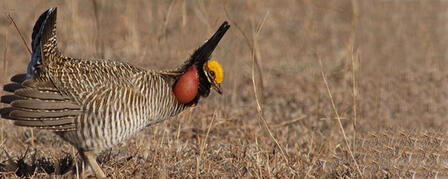FIRST RANGE-WIDE LESSER PRAIRIE CHICKEN AERIAL SURVEY CONCLUDED

June 14, 2012
New breeding grounds discovered in Kansas
EMPORIA — Surveys have now been concluded for the first range-wide assessment of lesser prairie chicken populations using common methods across portions of five states. The Lesser Prairie Chicken Interstate Working Group is composed of biologists from the state fish and wildlife agencies of Colorado, Kansas, New Mexico, Oklahoma, and Texas. The Working Group collaborated with federal agencies and West Ecosystems, Inc., of Laramie, Wyo., to conduct the large-scale, helicopter-based survey to locate lesser prairie chicken leks across the High Plains in all five states.
Leks, which are also referred to as gobbling grounds, are sites that the birds come to every spring for breeding. These surveys encompassed more than 300,000 square miles, and survey results will be used to produce the first statistically valid, five-state estimate of the number of leks by sometime later this summer.
The lesser prairie chicken has been considered a candidate under the Endangered Species Act (ESA) since 1998, and the U.S. Fish and Wildlife Service will release a proposed rule on the status of the bird under the ESA in September. Information from these surveys will be used as a baseline by these five state fish and wildlife agencies to monitor trends in prairie chicken populations and to target conservation programs in partnership with private landowners, oil and gas industries, and wind-energy and electric utilities.
“These surveys will be the basis for a range-wide lesser prairie chicken management plan that is being developed by the five states in collaboration with the Western Association of Fish and Wildlife Agencies Grassland Initiative,” said Jim Pitman, small game coordinator for the Kansas Department of Wildlife, Parks and Tourism. “The plan is expected to be completed by next March, and we are hopeful that it will preclude the need for the Fish and Wildlife Service to designate the lesser prairie chicken as a federally threatened or endangered species.”
The surveys this spring detected several previously unknown leks, despite the severe drought that occurred across the region last year. They also detected leks in Kansas that are beyond what was thought to be the northern extent of the historic range of the species. Lesser prairie chicken numbers have been largely increasing in Kansas for the last 15 years while populations have declined in parts of the southern portion of the range. Biologists believe this northward expansion may represent a shift in the population of the species caused by improved habitat from native grasses planted through the federal Conservation Reserve Program.
-30-







